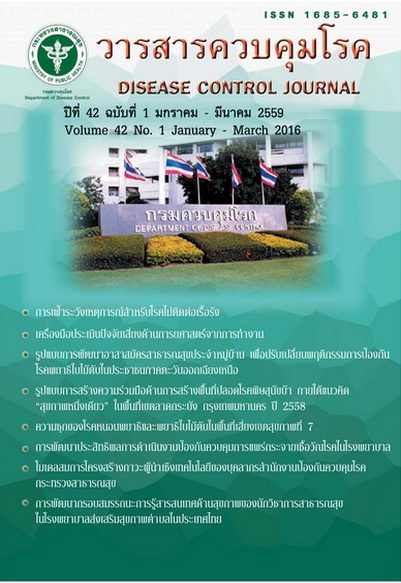Collaborative innovation and synergistic strategies for rabies free zone by using One Health approach in Lat Krabang District, Bangkok in 2015
DOI:
https://doi.org/10.14456/dcj.2016.30Keywords:
collaborative innovation and synergistic strategies surveillance, One Health concept, rabies preventionAbstract
Rabies is a fatal zoonotic disease and it remains a major public health problem in Thailand. The situation of human rabies in Bangkok from 1991 to 2015 revealed the main source of infections were dogs, accounted for 97.18% (69/71) and most of them (53.97%) were strayed. Meanwhile, 254 lab positive rabies in animals have been reported since 2011 with repeated rabid animals in the same areas for consecu¬tive years, especially 12 rabid animals in Lat Krabang District. This project aimed to develop a model of integrated prevention and control measures, comprehensive surveillance by multiple sectors and stakeholders in the area to reduce risk of disease transmission in humans and animals by engaging public health profes¬sionals, school teachers and community leaders under the “One Health” approach. The study was conducted from May to August 2015 and the key compositions included: (1) empowering communities to develop their own zoonotic surveillance capacities at household level, (2) integrating and synergizing activities between public health and livestock officers, (3) improving working environment and strengthening law enforcement, and (4) creating efficient reports in both intra-organizational and inter-organizational network. After im¬plementation, the following outcomes were observed/detected, i.e., (1) rapid notification of suspected cases of rabid animals and data sharing among network. Of the 17 lab positive rabid animals, one was from Lat Krabang District but no human rabies case, (2) rabies pre-exposure prophylaxis was given to a risk group of 377 persons, increasing from 56.00% to 91.00%, (3) a service of animal registry by community lead¬ers was done with a total of 14,134 animals registered including 8,794 dogs, 5,213 cats and 127 other species, (4) a total of 12,096 animals were vaccinated and rabies vaccination coverage in domestic animals was increased from 25.00% to 85.60%, (5) more animal shelters (from 2 to 9 shelters) and relevant res¬cues were a result of an expanding cooperation with the communities, (6) animal sterilization by mobile units were placed in the communities to control animal populations, and (7) rabies quarantine site for animals in both exposed group to suspected and confirmed cases of rabies was established. Finally, no rabies in animals and human was detected since Feburary 2015. In conclustion, stronger community participation and involve¬ment of all sectors in rabies surveillance and control was a key of success and this work under “One Health” approach demonstrated increased local ownership and ability to prevent disease transmission from animal to human as well as reduce the rabies incidence in the animals. Advocating this collaborative model, and syn¬ergistic strategies under “One Health” approach was recommended. A plan for scaling-up the model in other disctricts that experienced the same problem and similar context should be developed in line with the national target of rabies-free country in 2020.
Downloads
References
2. Catherine M. Brown. Compendium of animal rabies prevention and Control. Morbidity and Mortality Weekly Report [Internet]. 2011 [cited 2011 Nov 4] 60(RR06);1-14. Available from: https://www.cdc.gov/mmwr/preview/mmwrhtml/rr6006a1.htm
3. สถาบันสุขภาพสัตว์แห่งชาติ. หนังสือประกอบการฝึกอบรมโรคติดต่อระหว่างสัตว์และคน (zoonosis). กรุงเทพมหานคร: กรมปศุสัตว์ กระทรวงเกษตรและสหกรณ์; 2546.
Downloads
Published
How to Cite
Issue
Section
License
Articles published in the Disease Control Journal are considered as academic work, research or analysis of the personal opinion of the authors, not the opinion of the Thailand Department of Disease Control or editorial team. The authors must be responsible for their articles.






